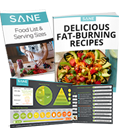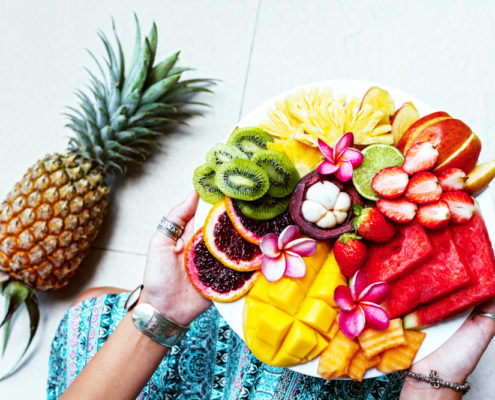Healthy Summer Foods Perfect For a Cookout
It’s that time of year again, the season of fun in the sun. Pool parties. Picnics. Cookouts. Chances are you’ll attend several cookouts this summer, which can make it challenging to keep your weight down. After all, healthy summer  foods are usually not the main feature of most cookouts.
foods are usually not the main feature of most cookouts.
Instead, there is usually a spread of decadent desserts, salty snacks loaded with unhealthy trans fats, sodas, and sugary foods everywhere. Oh, some healthy foods are there, too, but they are probably only masquerading as healthy summer foods.
- Like that fruit salad with thick citrus and honey syrup.
- Or that green salad consisting of nutrient-poor iceberg lettuce with your choice of highly processed salad dressings.
- Or how about those baked beans that have been stewed for hours in molasses or brown sugar?
None of these are healthy summer foods. But there is a way for you to have healthy summer foods at your next cookout, as long as you know what that term means.
What are healthy summer foods?
Here is what SANE healthy summer foods are and how you can recognize them.
Healthy summer foods are:
Minimally processed
Most foods in grocery stores have been processed to a certain extent, and not all processed foods are bad. It’s level of processing that makes them inSANE. Minimally processed foods, such as frozen produce or whole nuts packed into bags, are perfectly fine. Minimally processed foods have been…well…minimally processed, which does not change the structure of the food.
Processed foods are those in which their basic nutritional structure has been changed. The pasteurization of milk is an example. This is not necessarily bad, but not as beneficial as eating whole or minimally processed foods.
Ultra-processed foods, however, no longer resemble the plant or animal sources from which they originated. They have been stripped of fiber and most of their nutrients. They are manufactured foods filled with salt, sugar, preservatives, and other chemicals. A steady diet of ultra-processed foods breaks your metabolic system, damages your hormones, causes brain inflammation, and elevates setpoint weight.
Whole foods
Whole foods are easy to recognize once you know what you’re looking for. They are as close to their natural states as possible. For instance, if you’re shopping for vegetables, a whole food choice is a vegetable that you could have picked yourself. This means if you need carrots, select whole carrots or ones chopped up in a bag. Frozen carrots are okay, too. Canned carrots, however, are not a healthy choice because they have been ultra-processed.
If you’re shopping for meats, a whole-food choice is an animal you could have hunted yourself if you had wanted to. All meats for sale have been processed in that the animals from which they originated had to be slaughtered and then prepared for market. So, choosing any of the meats in the butcher’s section of the store should be fine as long as they haven’t had any extra processing methods performed. Meat in the freezer section is also okay as long as it doesn’t have any preservatives and other chemicals added to it. (Be sure to read the ingredient label.)
Whole grains are NOT whole foods
Don’t confuse whole grains with whole foods. They are not the same. You cannot go out to the wheat field, pick a stalk of wheat, and eat it. Whole-wheat bread, whole-grain pasta, and whole-grain cereals are heavily processed before they reach grocery store shelves. This is why they do not qualify as whole foods.
But while we’re on the subject, whole grains are also not part of a SANE diet, for a couple of reasons. The first is that they are not as filling when compared calorie-for-calorie to SANE non-starchy veggies and nutrient-dense proteins. Have you ever noticed how you can eat a bowl of whole-grain cereal or a couple of slices of whole-wheat toast and be hungry an hour later? They also make glucose levels skyrocket, leading to fat storage, and they are not as nutritious as non-starchy veggies.
Speaking of non-starchy vegetables…
Non-starchy vegetables
Non-starchy vegetables are one of the essential SANE food groups that trigger the release of fat-burning hormones, heal biological factors preventing weight loss, and lower your setpoint weight. The more non-starchy veggies and other SANE foods you eat, the less room you’ll have for inSANE foods. At your next cookout, load your plate with non-starchy vegetables first, and you’ll be way too full for any of those sickening sweet goodies!
Here are some great non-starchy vegetables perfect for grilling:
- Asparagus
- Broccoli
- Eggplant
- Tomatoes
- Zucchini
- Onions
- Spinach
- Kale
Nutrient-dense proteins
Whenever you consume nutrient-dense protein, it signals your short- and long-term satiety hormones. This means protein is one of the best foods you can eat if you want to get full fast and stay full for hours. Upping your protein intake also triggers muscle protein synthesis, helping you to build lean muscle mass. The more lean muscle you have, the higher your metabolism.
Here are some proteins to bring to your next cookout:
- Grass-fed ground beef
- Salmon
- Chicken
- Nonfat Greek yogurt (makes a great SANE veggie dip, just add fresh-squeezed lemon juice or a packet of ranch seasoning and dip mix.)
- Lean meats (make sure all skin is removed)
- Liver
- Cod
- Elk
Whole-food fats
These are foods found directly in nature and contain more calories from fat than from protein or carbohydrates, such as nuts, seeds, and olives. A SANE diet emphasizes eating whole-food fats — and NOT the oils from these foods — because they contain healthy fiber, protein, and water that helps lower setpoint weight.
Like non-starchy veggies and nutrient-dense proteins, whole-food fats are very filling. Plus, if you replace starchy carbs and sugars with whole-food fats, your body will soon start burning fat as its preferred fuel source.
Here are some great whole-food fats that are great on their own as munchies, or you can use them to add some SANEity to after-cookout desserts.
- Avocado
- Cocoa/cacao
- Coconut
- Almonds
- Walnuts
- Flaxseeds
- Olives
- Chia seeds
Low-fructose fruits
Low-fructose fruits are a great way to satisfy a sweet tooth. Try some of these at your next cookout. They go great in a fruit salad or fruit bowl.
- Acai Berries
- Apricots
- Blueberries
- Cherries
- Lemons
- Oranges
- Peach
- Strawberries
No added sugar/no starchy carbs
If you eat more whole foods — non-starchy vegetables, nutrient-dense proteins, whole-food fats, and low-fructose fruits — you will automatically eat fewer starchy carbs and foods with added sugar. That’s a good thing because refined sugar and starchy carbs cause a spike in blood sugar levels, increasing fat storage. Overconsumption of sugar has been linked to obesity, type 2 diabetes, fatty liver disease, heart disease, and other illnesses. It also elevates your setpoint weight even when consumed within an acceptable calorie limit.
Now, let’s talk about specific healthy summer foods.

Healthy summer foods: the main course
The main course at most cookouts is usually meat, so we’ll begin by showing you the SANE way to transform your meat dishes into healthy summer foods.
Hamburgers
Most people purchase “regular” ground beef for hamburgers, and the cheaper the package, the more fat it contains. The fat isn’t really the problem. You need the fat if you want to make juicy burgers. The problem with commercially raised beef is that it usually contains antibiotics, growth hormones, and other chemicals. That makes commercially raised beef burgers an unhealthy summer food. The solution?
Choose grass-fed ground beef or patties. Grass-fed ground beef contains less fat than commercially raised beef, and it has a better nutritional profile. For instance, grass-fed ground beef contains as much as 5 times more heart-healthy omega-3 fatty acids than commercially raised beef and almost twice as much conjugated linoleic acid (CLA). CLA is a fatty acid that boosts metabolism, torches fat, reduces inflammation, and strengthens the immune system.
By the way, if you want to make your burger one of those super healthy summer foods, pitch the bun. The typical hamburger bun is made with starchy flour that raises blood sugar levels quickly. Unless you make your own hamburger buns with almond or coconut flour, eat your burger with a fork. Or, better yet, replace the bun with two huge spinach or romaine lettuce leaves. (Put your burger between the two leaves, using the leaves as the bun.) They add a flavorful crunch and are loaded with free-radical-busting antioxidants, vitamins, and minerals.
Chicken
Forget about bringing fried chicken to a cookout. Not only are the cheap vegetable oils often used to fry chicken unhealthy, but carcinogens can form when carbohydrates are fried. (If the chicken is breaded, it contains carbohydrates.)
What is a healthy summer food choice instead? Simply purchase humanely raised chicken, remove the skin, and put it on the grill. Some spices to sprinkle on chicken include black pepper, cumin, paprika, and turmeric.
Turkey burgers
This is an easy one. Just purchase turkey burgers and grill them. There is one tiny problem, however. Turkey doesn’t have much fat, so it doesn’t hold together as well as a hamburger does. Be gentle when flipping them on the grill!
Fish
When you think of healthy summer foods, fish probably isn’t the first thing that comes to mind. But fish is very healthy and easy to grill. Any type of fish is healthy, but oily fish is super healthy. Try salmon, tuna, herring, or mackerel on the grill. Flavor with a spritz of lemon. Some herbs that taste great on fish include dill, lemon balm, marjoram, thyme, and rosemary.
Side dishes
 Forget the potato salad, baked beans, and all those other foods that spike your blood sugar levels. Here are some great healthy summer foods that make great side dishes, too!
Forget the potato salad, baked beans, and all those other foods that spike your blood sugar levels. Here are some great healthy summer foods that make great side dishes, too!
Grilled veggies
Many non-starchy vegetables taste great grilled.
Eggplant
Eggplant is tasty food and oh-so nutritious. It is loaded with vitamins C, K, and B6, potassium, dietary fiber, and much more. Cut it into 1-inch thick slices, lightly coat it with coconut oil, and grill for 6 minutes on each side or until tender. The finished dish will be crunchy on the outside, and delightfully creamy on the inside!
Here are some other non-starchy vegetables you can grill and season to taste. They make delicious side dishes, snacks, or toppings for any of the meats.
- Asparagus
- Romaine lettuce
- Kale
- Tomatoes
- Portobello Mushrooms
Grilling gives these veggies a smokey flavor.
Salads
Dinner Salad
No cookout would be complete without summer greens. You can make a summer greens salad with a mixture of any greens you please, such as kale, spinach, lettuce, and broccoli. Add your choice of onions, tomatoes, olives, and cucumbers. Instead of using inSANE commercial salad dressings, lightly toss with oil and vinegar or spritz with freshly squeezed lemon juice.
Fruit Salad
Healthy summer foods include a variety of fruit salads. Simply add a mixture of low-fructose fruits together. Some tasty combinations include blueberries and strawberries. If you need them to be a bit sweeter, use Stevia or another natural sweetener.
Beverages
Most cookouts are overrun with soda, which is an inSANE choice. Many studies show sodas contribute to weight gain, type 2 diabetes, tooth decay, and several other conditions. It’s best just to steer clear of sodas as much as possible. Fortunately, there are many SANEr alternatives.
Instead of sodas, try these healthy summer beverage alternatives:
- Iced green tea sweetened with the natural sweetener Erythritol.
- Homemade lemonade sweetened with Stevia, a natural sweetener.
- Green smoothies made with kale or spinach and your choice of a low-fructose fruit.
- SANE homemade soda: Blend carbonated water with your choice of low-fructose fruit. Sweeten with Stevia or another natural sweetener, if necessary. (One serving of low-fructose fruit for each serving of soda.)
Healthy summer foods: munchies
Every cookout has munchies, and like every other category, there are SANE alternatives.
Instead of potato chips, pretzels, etc., try some of these:
- Baked kale chips
- Raw veggies: broccoli, celery, carrots, cauliflower
- Raw nuts: almonds, walnuts, pistachio, macadamia, cashew
- Seeds: pumpkin, sesame, flax, chia
- Healthy summer foods for a cookout are not that hard to find when you do it the SANE way.
Next step: Enjoy summer foods with SANE
Ready to finally break free from the yo-yo dieting rollercoaster by balancing your hormones and lowering your body’s setpoint weight?
Want to know the exact foods and serving sizes that are scientifically proven by over 1,300 peer-reviewed research studies to boost metabolism, burn fat, and enjoy virtually effortless weight loss like a naturally thin person?
Download the free SANE metabolism boosting food list, cheat sheet, and “Eat More, Burn More” weight loss program by .





